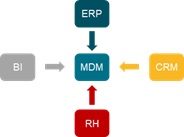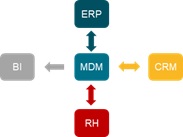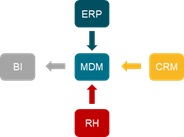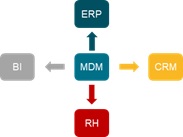What is MDM?
MDM (Master Data Management) is the combination of methods, tools and processes to ensure that a data, identified as transverse in the company, is unified (both in terms of definition and quality) and therefore usable without ambiguity by all the services of this company.
Implementing an MDM system will therefore involve the implementation of a data repository aiming to guarantee the quality and uniformity of the data through steps such as data cleansing, standardization, enrichment, consistency, the deduplication as well as the establishment of a Data Dictionary describing each data through a common definition to all the services of the company.
MDM and business processes
We cannot talk about MDM without talking about business processes :
- Because the Data lifecycle (its creation, update and even deletion) is linked to (a) business process(es), then the MDM system implementation will have to be integrated into the business processes, even if it means reviewing them, which in many cases will be profitable anyway.
- An MDM system is not uniquely intended to be used for a BI system. An MDM system is primarily an operational system that must unify a data within the entire IS. We are not just talking about consolidation (“BI” perspective) but reconciliation of operational data.
- The impact on business processes will be more or less important depending on the strategy that will be decided; strategy that may depend on the company organization (centralized or not with homogeneous IS or not) inherited in general from its growth history; indeed, a company that has grown up making acquisitions of other brands risks having a very decentralized organization with a heterogeneous IS unlike a company that has evolved differently.
- Each data identified as “Master Data” must be “owned” by a Data Owner who will be responsible for the creation, updating, propagation of the data and its deletion within the IS of the enterprise but also and especially its quality. This also implies a strong access rights management to the MDM system.
Implementation approaches
We will categorize 4 major ways of an MDM system implementations that have more or less impact on business processes :
|
RECORD |
|
 |
This first mode is the least impacting on business processes. It is also the one that has the least operational interest; actually, it is only records within a centralized repository. All systems (operational and BI) are responsible for the right updating and quality of the Master Data in the MDM system. |
|
CONSOLIDATE |
|
|
|
The second mode has little impact on business processes. This is an implementation mode that will be mainly found in a data consolidation objective for reporting at group level within a decentralized company where each subsidiary has its own IS (or even its own MDM system). Each subsidiary will send its repository which will then be centralized and transcoded. Again, the MDM system does not meet its business objective within the IS. |
|
CO-EXIST |
|
 |
This third mode, on the other hand, fully fulfils its objective of unifying data within the entirety of the IS. Consequently, the business processes must be reviewed accordingly; example: a client object can still be created in an ERP or CRM system but it will also be possible to create it in the MDM tool where the data will be unified and returned to the different operational systems. This mode also implies an important work on data synchronization between systems and therefore a high-performance flow architecture and a first definition of Data Governance. |
|
CENTRALIZE |
|
|
|
This last mode is the most impactful on the business processes because the entire data lifecycle is managed only in the MDM system, so there is acculturation and support to be provided to the business lines (Change Management). The advantage, in addition to also fully fulfilling its objective of unifying the data within the entire IS is that the version of truth, the reference (Golden Record), is found all the time in the MDM system; similarly, interfacing is easier because it only requires the dissemination of the Master Data. It is also this mode that will facilitate the data lineage (traceability of changes) because all value changes of the data will be made in the same place; important in an environment with high regulatory stakes (bank, insurance…) |
Risks… and Benefits
Let us be clear: most MDM implementation projects have failed. Companies wanting to have an MDM system have systematically encountered a pitfall: trying to reach agreement between different services and businesses on a common definition of what is a business object including its “business key” (concept we also find in the Data Vault – see articles on this topic).
Therefore, to launch into an MDM project implementation without having a high level and involved business sponsorship to decide and make decisions, is doomed to failure.
It is therefore important to make the businesses aware of their leading role in this kind of project.
To involve a business sponsor, there is nothing like presenting the benefits of an MDM system. There are many:
- Have a definition reference of its business objects
- Speaking of ROI, the immaterial value of what is a controlled quality reference data is very important
- Overhaul (and centralize) the business processes – allowing if necessary, to move towards a Business Process Management approach…
- Finally, be able to have a 360 vision of its business objects through the IS
- …
On the other hand, businesses must be aware of the necessary level of involvement they must have in these projects, both on the business definition (Data Owner) and on the reliability of the data and its propagation (Data Steward).
To sum up and considering that an MDM system can, depending on the Master Data it manages, merge several modes of implementation; except the first mode without great interest 😉, there is no good or bad implementation mode of its MDM system; there is a mode that best fits with its organization, it IS, its data governance maturity and its will.



Recent Comments